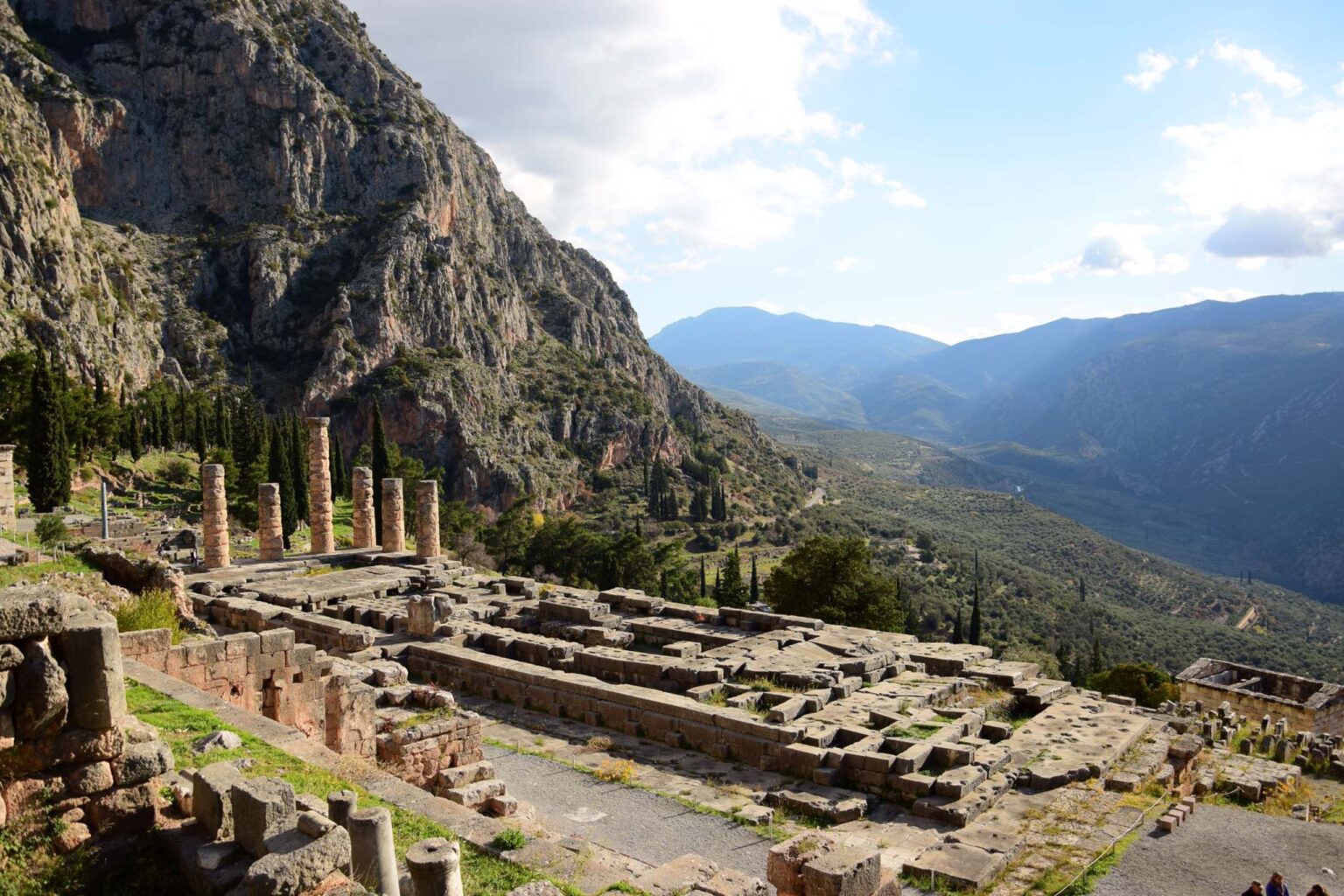We will visit:
- Battle of Chaeronea Museum or
- Osios Lukas Byzantine Monastery
- Delphi Orcle
- Delphin Archelogical Museum
Starting our tour to Delphi we drive northwest along the national highway to reach Chaeronea of Boeotia. Thebes of Boeotia was a major force in Greek history, and was the most dominant city-state at the time of the Macedonian conquest of Greece. The Sacred Band of Thebes (an elite military unit) famously fell at the battle of Chaeronea in 338 BC against Philip II and Alexander the Great. Battle of Chaeronea Archaeological Museum contains beautiful mosaic floors, remains of Cadmea as well as many other ancient remains from nearby areas. There you can admire the Lion of Chaeronea, a nearly 20-foot-tall (6.1 m) funerary monument erected in honor of the Sacred Band, as well as the bust of the ancient biographer and essayist Plutarch, born in Chaeronea.
Alternatively, we drive up near Distomo at Hosios Loukas Monastery, situated at a scenic site on the slopes of Mount Helicon. The beginning of the monastic activity in the region starts from the Hosios Lukas himself, living there the last years of his life, from 946 to 953 when he died at the age of 56. It is one of the most important monuments of Middle Byzantine architecture and art, and has been listed on UNESCO’s World Heritage Sites. It consists of a complex of two churches, the monastery of the Virgin Mary dating to the second half of the 10th century and the Catholic, built in the first decades of the 11th century to house the relics of Saint within an underground crypt. The mosaics that decorate the walls of the Catholic are top masterpieces of Byzantine art. Hosios Loukas was known and loved, as he lived. .He treated patients, advised people to different types of problem and was gifted with the ability to foresee the future; he had predicted the conquest of Crete 20 years ago. The relics of St. Luke were said to have exuded Myron, a sort of perfumed oil which produced healing miracles.
Continuing our tour towards Delphi we drive through Arachova situated at Parnassos Mountain. It is a picturesque settlement of magnificent view with traditional elements, one of the most popular winter resorts of Athenians and VIPs due to its snow center, its natural beauties and vivid lifestyle.
After a while we reach the Pan-Hellenic Sanctuary of Delphi which was the most famous oracle of ancient Greece. Delphi was regarded as the centre- the navel of the world. According to mythology Zeus sent out two eagles from the ends of the universe to find the navel of the world and they were met at the point of the oracle. It was for many centuries the cultural and religious centre and symbol of unity for the Hellenic world. Following the Sacred Way, leads to the temple of Apollo with its famous Adyton, where Pythia delivered her oracles and priests of Apollo interpreted them. Cities, rulers and ordinary people consulted the oracle, expressing their gratitude with great gifts gathered to small votive buildings-Treasuries, often displaying the glory of entire cities that offered them, like the Treasury of Athenians.
The archaeological site of Delphi includes- among other buildings- two sanctuaries, dedicated to Apollo and Athena. We first encounter the sanctuary of Athena Pronaia and within the walls we see the famous Tholos, the symbol of Delphi today.
Going northwest we come across the Gymnasium, a place for exercise and learning, the Palaestra and the Baths. Further up, the Castalian spring, the sacred spring of Delphi, were travelers satisfied their thirst and purified themselves before consulting the oracle. Above the temple is the Theatre where the theatrical and musical contests of the Pythian Games took place every four years, to honor Apollo for his victory over dragon Python who guarded Goddess Earth. These were the second most important games in Greece after the Olympics. Finally, the Stadium where the athletic contests were held.
Last but not least, the 2270m2 Archaeological Museum of Delphi, with 14 exhibition rooms, 558m2 of storerooms and conservation laboratories, of the most important in Greece, exhibiting by architectural sculpture, statues and minor objects the history of the Delphic sanctuary from its birth to its decline.
After the museum visit we take lunch at a very nice traditional restaurant with olive trees valley view, before we take our way back to Athens…
Delphi Tour Details
Duration : approx. 9 hrs
Booking Request
Ticket information and Opening Times
Tickets : Full: €3, Reduced: €2
Opening Hours : 09:00 – 17:00
Opening Hours
- Winter : 8.00- 15.00(Last admission 14.30)
- Summer : 8:00-20:00 (Last admission 19.30)
Full: €12, Reduced: €6
Valid for Museum & Archaeological Site
Winter Season 1/11 – 31/3
OPENING HOURS: 08: 30-15: 30, Tuesday closed
TICKETS 2€
In the winter season all visitors are entitled to a reduced ticket.
Summer Season 1/4 -31/10
OPENING HOURS: 08:30 – 15:30, Tuesday closed
TICKETS Full: 3€ Reduced: 2€
- March 6 (in memory of Melina Mercouri)
- April 18 (International Monuments Day)
- May 18 (International Museums Day)
- June 5 (International Enviroment Day)
- September 27 (International Tourism Day)
- October 28 (Greek National Holiday)
- The last weekend of September (European Heritage Days)
- Sundays from November 1st till March 31st
- The first Sunday of every month except July, August & September
- Admission is free for the students of EU and children under 18 years.
- People with special needs free; there is no ramp and no wheelchair is provided
Your professional driver has limited knowledge of Greek history, mythology as well as contemporary life and traditions. He is not allowed by law to accompany you into the sites and museums; therefore he will be waiting for you at the agreed area.
Private Hellas Tours cooperates with professional, licensed private tour guides, that you can hire and will ride the same vehicle with you, accompany you to the sites and museums and give you detailed information on the history of the landmarks and historical sites.

